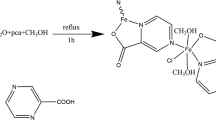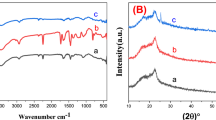Abstract
Zinc oxide-doped carbon nanofiber composite electrodes are fabricated using a one-step electrospinning process followed by thermal treatment. The composite electrodes were characterized using X-ray diffraction, Fourier transform infrared spectroscopy, X-ray photoelectron spectroscopy, scanning electron microscopy, transmission electron microscopy and contact angle measurements. The electrochemical performance of the composite electrodes was studied using three electrode and two electrode measurements in 6 M aqueous KOH electrolyte solution. The capacitive performance of the electrode increased with the increasing of zinc oxide content. The largest specific capacitance is found to be 184 Fg−1 at 0.5 Ag−1 and 90 Fg−1 at 0.5 Ag−1 current density in three electrode and two electrode measurements, respectively. The excellent electrochemical activity is due to the improvement in hydrophilic behaviour and interconnected structure, which offer low resistance paths towards ionic transportation. Furthermore, the composite electrode exhibits an energy density of 12.5 Wh kg−1 at a power density of 500 Wh kg−1. Additionally, the supercapacitor electrode exhibits excellent cycle life with capacitance retention of about 100% of its initial value after 2000 cycles at 2 Ag−1 current density. This excellent cycling stability and high performance will have the potential for promising applications in supercapacitor electrode materials.




















Similar content being viewed by others
Data availability
All data that support the findings of this study are included within the article (and any supplementary files).
References
H. Shen, A. Gele, Facile synthesis of N-doped lignin-based carbon nanofibers decorated with iron oxides for flexible supercapacitor electrodes. Inorgan. Chem. Commun. 128, 108607 (2021). https://doi.org/10.1016/j.inoche.2021.108607
S. Zhang, N. Pan, Supercapacitors performance evaluation. Adv. Energy Mater. 5(6), 1401401 (2015). https://doi.org/10.1002/aenm.201401401
Y.Z. Zhang, Y. Wang, T. Cheng, W.Y. Lai, H. Pang, W. Huang, Flexible supercapacitors based on paper substrates: a new paradigm for low-cost energy storage. Chem. Soc. Rev. 44(15), 5181–5199 (2015). https://doi.org/10.1039/c5cs00174a
G. Ghanashyam, H.K. Jeong, Synthesis of nitrogen-doped plasma treated graphite for supercapacitor applications. Chem. Phys. Lett. 725, 31–37 (2019). https://doi.org/10.1016/j.cplett.2019.04.012
D. Sridhar, J.L. Meunier, S. Omanovic, Directly grown carbon nano-fibers on nickel foam as binder-free long-lasting supercapacitor electrodes. Mater. Chem. Phys. 223, 434–440 (2019). https://doi.org/10.1016/j.matchemphys.2018.11.024
G. Ghanashyam, H.K. Jeong, Synthesis of plasma treated nitrogen-doped graphite oxide for supercapacitor applications. J. Energy Storage 26, 100923 (2019). https://doi.org/10.1016/j.est.2019.100923
L. Chen, Z. Wen, L. Chen, W. Wang, Q. Ai, G. Hou et al., Nitrogen and sulfur co-doped porous carbon fibers film for flexible symmetric all-solid-state supercapacitors. Carbon 158, 456–464 (2020). https://doi.org/10.1016/j.carbon.2019.11.012
L. Chen, D. Li, L. Chen, P. Si, J. Feng, L. Zhang et al., Core-shell structured carbon nanofibers yarn@ polypyrrole@ graphene for high performance all-solid-state fiber supercapacitors. Carbon 138, 264–270 (2018). https://doi.org/10.1016/j.carbon.2018.06.022
N.H.H. Phuc, M. Takaki, H. Muto, M. Reiko, H. Kazuhiro, A. Matsuda, Sulfur–carbon nano fiber composite solid electrolyte for all-solid-state Li–S batteries. ACS Appl. Energy Mater. 3(2), 1569–1573 (2020). https://doi.org/10.1021/acsaem.9b02062
J. Qi, J. Li, Y. Li, X. Fang, X. Sun, J. Shen et al., Synthesis of porous carbon beads with controllable pore structure for volatile organic compounds removal. Chem. Eng. J. 307, 989–998 (2017). https://doi.org/10.1016/j.cej.2016.09.022
K.H. Jung, J.P. Ferraris, Preparation of porous carbon nanofibers derived from PBI/PLLA for supercapacitor electrodes. Nanotechnology 27(42), 425708 (2016). https://doi.org/10.1088/0957-4484/27/42/425708
G.S. Chung, S.M. Jo, B.C. Kim, Properties of carbon nanofibers prepared from electrospun polyimide. J. Appl. Polym. Sci. 97(1), 165–170 (2005). https://doi.org/10.1002/app.21742
H. Pan, J. Yang, S. Wang, Z. Xiong, W. Cai, J. Liu, Facile fabrication of porous carbon nanofibers by electrospun PAN/dimethyl sulfone for capacitive deionization. J. Mater. Chem. A 3(26), 13827–13834 (2015). https://doi.org/10.1039/c5ta02954f
G. Duan, S. Liu, H. Hou, Synthesis of polyacrylonitrile and mechanical properties of its electrospun nanofibers. E-Polymers 18(6), 569–573 (2018). https://doi.org/10.1515/epoly-2018-0158
G. Che, B.B. Lakshmi, C.R. Martin, E.R. Fisher, R.S. Ruoff, Chemical vapor deposition based synthesis of carbon nanotubes and nanofibers using a template method. Chem. Mater. 10(1), 260–267 (1998). https://doi.org/10.1021/cm970412f
I. Giraud, S. Franceschi-Messant, E. Perez, C. Lacabanne, E. Dantras, Preparation of aqueous dispersion of thermoplastic sizing agent for carbon fiber by emulsion/solvent evaporation. Appl. Surf. Sci. 266, 94–99 (2013). https://doi.org/10.1016/j.apsusc.2012.11.098
T.K. Pani, B.B. Sahoo, B. Sundaray, Carbon electrodes derived from polyacrylonitrile-polyethylene glycol blend for high-performance supercapcitor. Mater. Res. Express 6(12), 125077 (2019). https://doi.org/10.1088/2053-1591/ab59e7
T. Yumak, D. Bragg, E.M. Sabolsky, Effect of synthesis methods on the surface and electrochemical characteristics of metal oxide/activated carbon composites for supercapacitor applications. Appl. Surf. Sci. 469, 983–993 (2019). https://doi.org/10.1016/j.apsusc.2018.09.079
H. Wang, H. Niu, H. Wang, W. Wang, X. Jin, H. Wang et al., Micro-meso porous structured carbon nanofibers with ultra-high surface area and large supercapacitor electrode capacitance. J. Power Sources 482, 228986 (2021). https://doi.org/10.1016/j.jpowsour.2020.228986
G. Ghanashyam, H.K. Jeong, Synthesis of nitrogen-doped plasma treated carbon nanofiber as an efficient electrode for symmetric supercapacitor. J. Energy Storage 33, 102150 (2021). https://doi.org/10.1016/j.est.2020.102150
G. Chen, T. Chen, K. Hou, W. Ma, M. Tebyetekerwa, Y. Cheng et al., Robust, hydrophilic graphene/cellulose nanocrystal fiber-based electrode with high capacitive performance and conductivity. Carbon 127, 218–227 (2018). https://doi.org/10.1016/j.carbon.2017.11.012
Y. Liu, C. Nie, X. Liu, X. Xu, Z. Sun, L. Pan, Review on carbon-based composite materials for capacitive deionization. RSC Adv. 5(20), 15205–15225 (2015). https://doi.org/10.1039/c4ra14447c
L.M. Chang, X.Y. Duan, W. Liu, Preparation and electrosorption desalination performance of activated carbon electrode with titania. Desalination 270(1–3), 285–290 (2011). https://doi.org/10.1016/j.desal.2011.01.008
X. Lei, B. Wang, J. Liu, Z. Ye, Z. Chang, M. Jiang, X. Sun, Three-dimensional NiAl-mixed metal oxide film: preparation and capacitive deionization performances. RSC Adv. 4(78), 41642–41648 (2014). https://doi.org/10.1039/c4ra08415b
B. Yan, J. Zheng, F. Wang, L. Zhao, Q. Zhang, W. Xu, S. He, Review on porous carbon materials engineered by ZnO templates: Design, synthesis and capacitance performance. Mater. Des. 201, 109518 (2021). https://doi.org/10.1016/j.matdes.2021.109518
X. Li, Z. Wang, Y. Qiu, Q. Pan, P. Hu, 3D graphene/ZnO nanorods composite networks as supercapacitor electrodes. J. Alloy. Compd. 620, 31–37 (2015)
G. Huang, W. Zhang, S. Xu, Y. Li, Y. Yang, Microspherical ZnO synthesized from a metal-organic precursor for supercapacitors. Ionics 22(11), 2169–2174 (2016)
F. Ahmed, G. Almutairi, B. AlOtaibi, S. Kumar, N. Arshi, S.G. Hussain et al., Binder-free electrode based on ZnO nanorods directly grown on aluminum substrate for high performance supercapacitors. Nanomaterials 10(10), 1979 (2020)
C.T. Altaf, O. Coskun, A. Kumtepe, A.M. Rostas, I. Iatsunskyi, E. Coy et al., Photo-supercapacitors based on nanoscaled ZnO. Sci. Rep. 12, 1 (2022)
W.K. Chee, H.N. Lim, Z. Zainal, I. Harrison, N.M. Huang, Y. Andou et al., Electrospun nanofiber membranes as ultrathin flexible supercapacitors. RSC Adv. 7(20), 12033–12040 (2017)
J. Ju, N. Deng, D. Zhang, J. Yan, L. Li, W. Kang, B. Cheng, Facile construction of PCNF&CNT composite material by one-step simultaneous carbonization and chemical vapor deposition. J. Mater. Sci. 54(2), 1616–1628 (2019)
Y. Zhao, G. Luo, L. Zhang, L. Gao, D. Zhang, Z. Fan, Nitrogen-doped porous carbon tubes composites derived from metal-organic framework for highly efficient capacitive deionization. Electrochim. Acta 331, 135420 (2020)
Y.N. Liu, H.T. Wang, X.H. Kang, Y.F. Wang, S.Y. Yang, S.W. Bian, Cotton fabric and zeolitic imidazolate framework (ZIF-8) derived hierarchical nitrogen-doped porous carbon nanotubes/carbon fabric electrodes for all-solid-state supercapacitors. J. Power Sources 402, 413–421 (2018)
W. Wang, S. Jiao, J. Cao, H.E. Naguib, Zinc oxide/carbon nanotube nanocomposite for high-performance flexible supercapacitor with sensing ability. Electrochim. Acta 350, 136353 (2020)
L.F. Chen, Y. Lu, L. Yu, X.W.D. Lou, Designed formation of hollow particle-based nitrogen-doped carbon nanofibers for high-performance supercapacitors. Energy Environ. Sci. 10(8), 1777–1783 (2017). https://doi.org/10.1039/c7ee00488e
L.Q. Wei, J.Y. Lu, Q.Q. Li, Y. Zhou, L.L. Tang, F.Y. Li, A porous Ca-MOF with nano-sized Ca11 as building unit: structure, drug loading and release properties. Inorg. Chem. Commun. 100(78), 43–47 (2017). https://doi.org/10.1016/j.inoche.2017.02.010
A.V. Raghu, H.M. Jeong, J.H. Kim, Y.R. Lee, Y.B. Cho, K. Sirsalmath, Synthesis and characterization of novel polyurethanes based on 4-{(4-hydroxyphenyl) iminomethyl} phenol. Macromol. Res. 16, 194–199 (2008)
A.V. Raghu, G.S. Gadaginamath, H.M. Jeong, N.T. Mathew, S.B. Halligudi, T.M. Aminabhavi, Synthesis and characterization of novel Schiff base polyurethanes. J. Appl. Polym. Sci. 113(5), 2747–2754 (2009). https://doi.org/10.1002/app.28257
R. Zamiri, A. Rebelo, G. Zamiri, A. Adnani, A. Kuashal, M.S. Belsley, J.M.F. Ferreira, Far-infrared optical constants of ZnO and ZnO/Ag nanostructures. RSC Adv. 4(40), 20902–20908 (2014). https://doi.org/10.1039/C4RA01563K
J. Li, Y. Sun, W. Kang, P. Wang, H. Zhang, X. Zhang et al., Green synthesis of cellulose/graphene oxide/ZIF8 derived highly conductivity integrated film electrode for supercapacitor. Carbon 185, 599–607 (2021)
M.R. Pallavolu, J. Nallapureddy, R.R. Nallapureddy, G. Neelima, A.K. Yedluri, T.K. Mandal et al., Self-assembled and highly faceted growth of Mo and V doped ZnO nanoflowers for high-performance supercapacitors. J. Alloys Compd. 886, 161234 (2021)
N. Gogurla, A.K. Sinha, S. Santra, S. Manna, S.K. Ray, Multifunctional Au-ZnO plasmonic nanostructures for enhanced UV photodetector and room temperature NO sensing devices. Sci. Rep. 4(1), 1–9 (2014)
Y.G. Lin, Y.K. Hsu, Y.C. Chen, L.C. Chen, S.Y. Chen, K.H. Chen, Visible-light-driven photocatalytic carbon-doped porous ZnO nanoarchitectures for solar water-splitting. Nanoscale 4(20), 6515–6519 (2012)
U. Kurtan, U. Sahinturk, H. Aydın, D. Dursun, A. Baykal, CoFe nanoparticles in carbon nanofibers as an electrode for ultra-stable supercapacitor. J. Inorgan. Organometall. Polym. Mater. 30(9), 3608–3616 (2020). https://doi.org/10.1007/s10904-020-01524-7
S.C. Lin, Y.T. Lu, Y.A. Chien, J.A. Wang, T.H. You, Y.S. Wang et al., Asymmetric supercapacitors based on functional electrospun carbon nanofiber/manganese oxide electrodes with high power density and energy density. J. Power Sources 362, 258–269 (2017). https://doi.org/10.1016/j.jpowsour.2017.07.052
J. Huang, B. Zhang, Y.Y. Xie, W.W.K. Lye, Z.L. Xu, S. Abouali et al., Electrospun graphitic carbon nanofibers with in-situ encapsulated Co–Ni nanoparticles as freestanding electrodes for Li–O2 batteries. Carbon 100, 329–336 (2016). https://doi.org/10.1016/j.carbon.2016.01.012
C.H. Kim, B.H. Kim, Zinc oxide/activated carbon nanofiber composites for high-performance supercapacitor electrodes. J. Power Sources 274, 512–520 (2015). https://doi.org/10.1016/j.jpowsour.2014.10.126
J.H. Kwak, Y.W. Lee, J.H. Bang, Supercapacitor electrode with an ultrahigh Co3O4 loading for a high areal capacitance. Mater. Lett. 110, 237–240 (2013). https://doi.org/10.1016/j.matlet.2013.08.032
Q. Jiang, X. Pang, S. Geng, Y. Zhao, X. Wang, H. Qin et al., Simultaneous cross-linking and pore-forming electrospun carbon nanofibers towards high capacitive performance. Appl. Surf. Sci. 479, 128–136 (2019). https://doi.org/10.1016/j.apsusc.2019.02.077
H.B.M. Emrooz, A.A. Aghdaee, M.R. Rostami, Zinc-salt assisted synthesis of three-dimensional oxygen and nitrogen co-doped hierarchical micro-meso porous carbon foam for supercapacitors. Sci. Rep. 11(1), 1–11 (2021)
S. Lv, L. Ma, X. Shen, H. Tong, Dual pore-former method to prepare nitrogen-doped hierarchical porous carbons for supercapacitors. J. Alloy. Compd. 895, 162587 (2022)
G. Duan, L. Zhao, C. Zhang, L. Chen, Q. Zhang, K. Liu, F. Wang, Pyrolysis of zinc salt-treated flax fiber: Hierarchically porous carbon electrode for supercapacitor. Diamond Relat. Mater. 129, 109339 (2022)
G. Duan, L. Zhao, L. Chen, F. Wang, S. He, S. Jiang, Q. Zhang, ZnCl 2 regulated flax-based porous carbon fibers for supercapacitors with good cycling stability. New J. Chem. 45(48), 22602–22609 (2021)
Funding
The authors have not disclosed any funding.
Author information
Authors and Affiliations
Contributions
BBS: Conceptualization, Methodology, investigation, Formal analysis, Visualization, Writing original draft. BS: Supervision, validation, Review, Editing.
Corresponding author
Ethics declarations
Conflict of interest
The author claim that they have no personal relationship and no known competing financial interest that could have appeared to influence the work reported in this paper.
Additional information
Publisher's Note
Springer Nature remains neutral with regard to jurisdictional claims in published maps and institutional affiliations.
Rights and permissions
Springer Nature or its licensor (e.g. a society or other partner) holds exclusive rights to this article under a publishing agreement with the author(s) or other rightsholder(s); author self-archiving of the accepted manuscript version of this article is solely governed by the terms of such publishing agreement and applicable law.
About this article
Cite this article
Sahoo, B.B., Sundaray, B. Zinc oxide-doped carbon nanofibrous binder-free membrane for the development of supercapacitor electrode. J Mater Sci: Mater Electron 34, 1882 (2023). https://doi.org/10.1007/s10854-023-11250-8
Received:
Accepted:
Published:
DOI: https://doi.org/10.1007/s10854-023-11250-8




